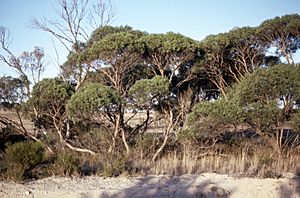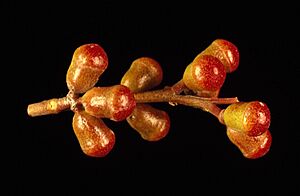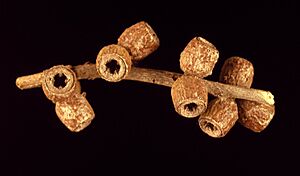Goblet mallee facts for kids
Quick facts for kids Goblet mallee |
|
|---|---|
 |
|
| Eucalyptus merrickiae near Scaddan | |
| Conservation status | |
| Scientific classification | |
| Genus: |
Eucalyptus
|
| Species: |
merrickiae
|
The Eucalyptus merrickiae, often called goblet mallee, is a special type of mallee tree. It only grows in a small area along the south coast of Western Australia. This plant has rough, flaky bark on its trunk and sometimes on its bigger branches. Its adult leaves are long and thin. The flowers grow in groups of three and are usually creamy white. After flowering, it produces interesting cylindrical fruit.
Contents
What the Goblet Mallee Looks Like
The goblet mallee is a type of mallee plant. It usually grows to be about 2 to 6 meters (6 to 20 feet) tall. Sometimes, it can also grow as a bushy shrub. This plant has a special woody swelling at its base called a lignotuber. This helps it regrow after fires.
Bark and Leaves
The bark on the trunk is rough and flaky. It is usually greyish. Sometimes, this rough bark also covers the base of the larger branches. The bark higher up on the plant is smooth and grey. The adult leaves are green on both sides. They are long and narrow, measuring about 50 to 85 millimeters (2 to 3.3 inches) long. They are also about 4 to 8 millimeters (0.16 to 0.31 inches) wide. Each leaf has a small stalk, called a petiole, which is about 4 to 8 millimeters long.
Flowers and Fruit
The flower buds of the goblet mallee grow in groups of three. Each group is on a short stalk, called a peduncle, about 2 to 5 millimeters long. The individual buds are shaped like cylinders. They are about 7 to 12 millimeters long and 5 to 6 millimeters wide. Each bud has a cap, called an operculum, which can be cone-shaped or rounded.
The goblet mallee flowers between August and November. Its flowers are usually creamy white, but sometimes they can be a bit pinkish. After the flowers, the plant produces woody fruit. These fruits are shaped like cylinders. They are about 6 to 10 millimeters long and 6 to 8 millimeters wide.
How it Got its Name
The Eucalyptus merrickiae was officially described in 1925. This was done by two botanists, Joseph Maiden and William Blakely. They published their description in a science journal. The second part of its scientific name, merrickiae, honors a person named Mary Merrick. She worked at the Royal Botanic Garden, Sydney from 1921 to about 1927.
Where the Goblet Mallee Lives
You can mostly find the goblet mallee near the northeastern side of salt lakes. These lakes are located east of the main highway. This area is between the towns of Scaddan and Salmon Gums in Western Australia. The plant prefers to grow in sandy soil or sandy clay.
Protecting the Goblet Mallee
The goblet mallee is considered a "vulnerable" species. This means it is at risk of disappearing. The Australian Government lists it as vulnerable under a law called the Environment Protection and Biodiversity Conservation Act 1999. The Department of Environment and Conservation (Western Australia) also lists it as "Threatened Flora."
The main reasons this plant is at risk are:
- There are only a small number of individual plants left.
- It grows in a very small and specific area.
These factors make it important to protect the goblet mallee.
Related pages
- Eucalyptus scyphocalyx, also known as the goblet mallee




